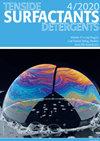The EU Detergent Industry Network ‘DetNet’ – an industry approach for the EU CLP classification of detergent and cleaning products for skin and eye effects
IF 1.2
4区 工程技术
Q4 CHEMISTRY, APPLIED
引用次数: 0
Abstract
The implementation of the EU CLP Regulation for mixtures in 2015 led to a reduction of the cut-off levels for mixtures containing severely irritating or corrosive ingredients. As a result, most everyday detergents would be required to carry the same corrosive pictogram on the label as caustic or highly acidic specialty cleaners. However, in most cases, calculation-derived skin and eye hazard classifications do not reflect in-market experience and consumer understanding of the hazardous properties of household detergents. The detergent industry responded to this situation by forming the Detergent Industry Network ‘DetNet’. It is a transparent process that supports mixture classification decisions by sharing data, expertise, and best practices between manufacturers of detergent and cleaning products. At the core of DetNet is its database providing access to compositional information and toxicological data on more than 240 detergents and cleaning products. This paper describes and discusses the main features of DetNet, its organisational structure and database. Based on a case study, the process and functioning of DetNet to support a scientifically sound classification of an untested mixture for skin and eye effects based on data available for similar mixtures is demonstrated.欧盟洗涤剂行业网络 "DetNet"--欧盟 CLP 针对洗涤剂和清洁产品对皮肤和眼睛的影响进行分类的行业方法
2015 年实施的欧盟混合物 CLP 法规降低了含有严重刺激性或腐蚀性成分的混合物的临界值。因此,大多数日常清洁剂都需要在标签上标注与腐蚀性或强酸性专用清洁剂相同的腐蚀性象形图。然而,在大多数情况下,通过计算得出的皮肤和眼睛危害分类并不能反映市场经验和消费者对家用洗涤剂危险特性的理解。针对这种情况,洗涤剂行业组建了洗涤剂行业网络 "DetNet"。这是一个透明的过程,通过在洗涤剂和清洁产品制造商之间共享数据、专业知识和最佳实践来支持混合物分类决策。DetNet 的核心是其数据库,可提供 240 多种洗涤剂和清洁产品的成分信息和毒理学数据。本文介绍并讨论了 DetNet 的主要特点、组织结构和数据库。在一个案例研究的基础上,演示了 DetNet 的流程和功能,以支持根据类似混合物的现有数据对一种未经测试的混合物进行科学合理的皮肤和眼睛影响分类。
本文章由计算机程序翻译,如有差异,请以英文原文为准。
求助全文
约1分钟内获得全文
求助全文
来源期刊

Tenside Surfactants Detergents
工程技术-工程:化工
CiteScore
1.90
自引率
10.00%
发文量
57
审稿时长
3.8 months
期刊介绍:
Tenside Surfactants Detergents offers the most recent results of research and development in all fields of surfactant chemistry, such as: synthesis, analysis, physicochemical properties, new types of surfactants, progress in production processes, application-related problems and environmental behavior. Since 1964 Tenside Surfactants Detergents offers strictly peer-reviewed, high-quality articles by renowned specialists around the world.
 求助内容:
求助内容: 应助结果提醒方式:
应助结果提醒方式:


